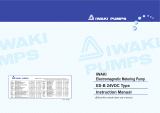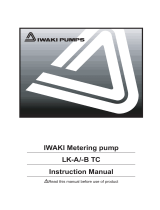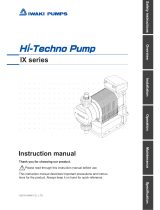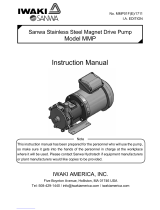Page is loading ...

Read this manual before use of product
IWAKI
Electromagnetic Metering Pump
ES-B/C Type
Instruction Manual
T636 '07/05
�
IWAKI CO.,LTD. 6-6 Kanda-Sudacho 2-chome Chiyoda-ku Tokyo 101-8558 Japan
TEL:(81)3 3254 2935 FAX:3 3252 8892(http://www.iwakipumps.jp)
U.S.A. : IWAKI America Inc.
Australia : IWAKI Pumps Australia Pty. Ltd.
Singapore : IWAKI Singapore Pte. Ltd.
Indonesia : IWAKI Singapore (Indonesia Branch)
Malaysia : IWAKIm Sdn. Bhd.
Taiwan : IWAKI Pumps Taiwan Co., Ltd.
Thailand : IWAKI (Thailand) Co.,Ltd.
Hong Kong : IWAKI Pumps Co., Ltd.
China :
GFTZ IWAKI Engineering & Trading Co., Ltd.
China : IWAKI Pumps Co., Ltd. (Beijing office)
China : IWAKI Pumps (Shanghai) Co., Ltd.
Philippines : IWAKI Chemical Pumps Philippines, Inc.
Korea : IWAKI Korea Co.,Ltd.
Vietnam :
IWAKI Pumps Vietnam Joint Venture Co.,Ltd.
TEL : (1)508 429 1440 FAX : 508 429 1386
TEL : (61)2 9899 2411 FAX : 2 9899 2421
TEL : (65)763 2744 FAX : 763 2372
TEL : (62)21 690 6607 FAX : 21 690 6612
TEL : (60)3 7803 8807 FAX : 3 7803 4800
TEL : (886)2 8227 6900 FAX : 2 8227 6818
TEL : (66)2 320 1303 FAX : 2 322 2477
TEL : (852)2 607 1168 FAX : 2 607 1000
TEL : (86)20 8435 0603 FAX : 20 8435 9181
TEL : (86)10 6442 7713 FAX : 10 6442 7712
TEL : (86)21 6272 7502 FAX : 21 6272 6929
TEL : (63)2 888 0245 FAX : 2 843 3096
TEL : (82)2 3474 0523 FAX : 2 3474 0221
TEL : (84)613 933456 FAX : 613 933399
Germany : IWAKI EUROPE GmbH
Italy : IWAKI Italia S.R.L.
Denmark : IWAKI Pumper A/S
Sweden : IWAKI Sverige AB
Finland : IWAKI Suomi Oy
Norway : IWAKI Norge AS
France : IWAKI France S.A.
U.K. : IWAKI PUMPS (UK) LTD.
Switzerland : IWAKI (Schweiz) AG
Austria : IWAKI (Austria) GmbH
Holland : IWAKI Holland B.V.
Spain : IWAKI Iberica Pumps, S.A.
Belgium : IWAKI Belgium n.v.
TEL : (49)2154 9254 0 FAX : 2154 1028
TEL : (39)02 990 3931 FAX : 02 990 42888
TEL : (45)48 24 2345 FAX : 48 24 2346
TEL : (46)8 511 72900 FAX : 8 511 72922
TEL : (358)9 2742714 FAX : 9 2742715
TEL : (47)66 81 16 60 FAX : 66 81 16 61
TEL : (33)1 69 63 33 70 FAX : 1 64 49 92 73
TEL : (44)1743 231363 FAX : 1743 366507
TEL : (41)32 3235024 FAX : 32 3226084
TEL : (43)2236 33469 FAX : 2236 33469
TEL : (31)297 241121 FAX : 297 273902
TEL : (34)943 630030 FAX : 943 628799
TEL : (32)1430 7007 FAX : 1430 7008

Thank you for selecting the IWAKI's electromagnetic metering pump ES series. This instruc-
tion manual deals with "Safety Instructions", "Outline", "Installation", "Operation" and
"Maintenance" sections.
Please read through this manual carefully to ensure the optimum performance, safety and
service of your pump.
Contents
Important instructions ····························································· 1
Safety instructions ·································································· 2
Outline 1. Safety and Caution Notes ················································ 5
2. Principle of Operation ····················································· 5
3. Specifications ·································································· 6
Installation 1. Unpacking ········································································ 8
2. Location ··········································································· 8
3. Supply Tubing ·································································· 9
4. Discharge Tubing ····························································· 9
5. Electrical ·········································································· 9
Operation 1. Priming ·········································································· 11
2. Adjustment ····································································· 11
3. Calibration ····································································· 12
Maintenance 1. Diaphragm Replacement ··············································· 14
2. Valve Replacement ························································ 14
3. Tubing ············································································ 14
4. Troubleshooting ····························································· 15
5. Model code ···································································· 16
6. Dimensions ···································································· 17
7. Exploded view ································································ 19
8. Parts list ········································································· 20
Contact us or your nearest dealer if you have any questions.

- 1 -
Important instructions
Nonobservance or misapplication of the contents of
“Caution” section could lead to a personal injury or
damage to the product.
For the Safe and
Correct Handling of the pump
● "Safety Instruction" section deals with important details about handling of the product. Before
the use of the pump, read this section carefully for the prevention of personnel injury or loss.
● Observe the instructions accompanied with "WARNING" or "CAUTION" in this manual. These
instructions are very important for protecting pump users from dangerous situations.
● The symbols on this instruction manual have the following meanings:
WARNING
Nonobservance or misapplication of the contents of
“Warning” section could lead to a serious accident
which may result in death.
CAUTION
Types of Symbols
Indicates that “Warning” or “Caution” must be exercised. Inside this triangle, a con-
crete and practical image provided as a warning or caution message is depicted.
Indicates a prohibited action or procedure. Inside or near this circle, a concrete and
practical image of the activity to be avoided is depicted.
Indicates an important action or procedure which must be performed or carried out
without fail. Failure to follow the instructions herein can lead to malfunction or
damage to the pump.

- 2 -
Safety instructions
● Turn off power
Working on the pump while the power is ON, you may be shocked. Be sure
to turn off the pump and related devices before any work.
● Terminate operation
Finding any abnormal condition, stop the operation immediately and
inspect/solve problems.
● For specified application only
The use of the pump in any application other than those clearly specified
may result in injury or damage. Use the pump in a specified condition.
● No modification
Do not modify the pump. We are not responsible for any accidents or dam-
age due to modification.
● Wear protective clothing
Always wear protective clothing such as safety goggles, protective gloves
when arranging piping or dismantling the pump.
● Do not place the pump close to water
The pump is not water-proof construction. The use of the pump in a humid
place or a place where the pump can bet wet, electrical shock or short-cir-
cuit may result.
CAUTION
WARNING
● Restriction on pump operator
The pump should be handled by a qualified person with a full understand-
ing of the pump.
● Specified power only
Do not apply any power other than the specified one on the nameplate.
Otherwise damage or fire may result.
● Do not run pump dry
Do not run pump dry. Parts friction heat is generated and damages the
pump if the pump runs without liquid.
● Do not wet the pump
If a liquid spills over electric parts or wires, a fire or electrical shock may be
caused. Install the pump in a place free from liquid spillage.
Electrical Shock
Prohibited
No Remodeling
Wear protective
gear
Prohibited
Prohibited
Prohibited
Prohibited
Do not wet
or dampen

- 3 -
Safety instructions
● Ventilate
Poisoning may result when handling toxic or odorous liquid. Ventilate the
operating site sufficiently.
● Countermeasure against efflux
Take a protective measure against the accidental efflux caused by the
pump or piping breakage.
● Damaged pumps
Do not use any damaged pump. Using a damaged pump could lead to an
electric leak or shock.
● Do not damage power cable
Do not scratch, damage, modify, or pull the power cable. Heating the cable
or placing a heavy thing on it may damage the cable and may result in a
fire or electrical shock.
● Install an earth leakage breaker
Risk of electrical shock. Do not run the product without an optional leakage
breaker. Secure a leakage breaker to reduce the risk of electrical shock.
Purchase separately.
● Damaged power cable
Do not use any damaged power cable for the prevention of a fire or electri-
cal shock. Handle the power cable with care.
● Wear parts replacement
Replace wear parts in accordance with instructions. Do not dismantle the
pump beyond the extension described on this manual.
● Limited operating site and storage
Do not install or store the pump in the following places...
1. Ambient temperature is beyond 0-40 dig.C.
2. Under a flammable atmosphere.
● Pump disposal
Any used or damaged pump must be disposed of in accordance with local
laws and regulations. (Consult a licensed industrial waste products dispos-
ing company.)
CAUTION
Caution
Caution
Prohibited
Electrical Shock
Electrical Shock
Prohibited
Caution

- 4 -
Outline
1.Safety and Caution Notes............... 5
2.Principle of Operation...................... 5
3.Specifications.................................... 6

- 5 -
Outline
1. Safety and Caution Notes
Avoid areas where ambient temperature exceeds 40 degrees Celsius or falls below 0 degrees Celsius, or
where the pump or tubing would be exposed to direct sunlight.
Disconnect the pump from electrical power source before performing any maintenance.
When working on or around a metering pump, always wear proper protective clothing and equipment as rec-
ommended by the supplier of the liquid being pumped.
Depressurize the discharge tubing before disconnecting the tubing or performing any maintenance on the
pump.
2. Principle of Operation
The ES series electromagnetic metering pump consists of a pump unit, a driving unit, and a control unit.
The drive unit is an electromagnetic solenoid. When the solenoid coil is energized by the control unit the
armature shaft moves forward due to the magnetic force of the solenoid. The shaft is attached to a PTFE
faced diaphragm which is part of the pump unit. The diaphragm is forced into the pump head cavity decreas-
ing volume and increasing pressure which forces liquid in the pump head out through the discharge check
valves. When the solenoid coil is de-energized, a spring returns the armature to its starting position. This
action pulls the diaphragm out of the head cavity increasing volume and decreasing pressure. Atmospheric
pressure then pushes liquid from the supply tank through the suction check valves to refill the pump head.

- 6 -
Outline
3. Specifications
Capacity/Pressure Rating
Model B11 B16 B21 B31 C16 C21 C31 C36
Max. capacity L/H 2.28 3.9 5.7 12.0 4.8 7.8 16.2 24.0
Max. capacity ml/min 38 65 95 200 80 130 270 400
Max. discharge pressure
MPa 1.0 0.7 0.4 0.2 1.0 0.7 0.35 0.2
Stroke rate 0 - 353 spm
Stroke length 1.00 mm (Fixed stroke length) 1.25 mm (Fixed stroke length)
Power supply 207 - 253VAC, 50Hz single phase
Average power con-
sumption 16 watt 22 watt
Connection tubing
ID×OD 4×6mm 9×12mm 4×6mm 9×12mm
• Max. capacity is measured with clean water under the Max. discharge pressure. Actual discharge capacity
may increase if the discharge pressure is low.
• Operating conditions
Ambient temperature: 0 - 40 degrees Celsius
Relative humidity : 35 - 90 % non-condensing
Liquid End Materials
Liquid End Part VH VC PH PC
Pump head PVC GFRPP
Diaphragm PTFE (bonded to EPDM)
Valve ball Hastelloy C276 Alumina Ceramics Hastelloy C276 Alumina Ceramics
Valve seat EPDM FKM EPDM FKM
Valve guide PVC GFRPP
Gasket PTFE
O ring EPDM FKM EPDM FKM
PVC: Polyvinyl chloride
GFRPP: Glass fiber reinforced polypropylene
PTFE: Polyterafluoroethylene
EPDM: Ethylene propylene diene monomer
FKM: Fluoroelastmer

- 7 -
Installation
1.Unpacking.......................................... 8
2.Location............................................. 8
3.Supply Tubing................................... 9
4. Discharge Tubing............................ 9
5. Electrical........................................... 9

- 8 -
Installation
1. Unpacking
Open the shipping carton and inspect contents for damage. If any items are messing or damaged, contact
your local distributor to arrange for replacement.
2. Location
Choose a location for the pump which is clean, dry, close to an electrical outlet, and allows convenient
access to frequency control and tubing connections. Avoid areas where ambient temperature exceeds 40
deg.C or falls below 0 deg.C, or where the pump or tubing would be exposed to direct sunlight.
Flooded suction (mounting the pump below the level of liquid in the supply tank) is strongly recommended,
especially when pumping liquids that readily generate gas bubbles (See Figure 1). Sodium hypochlorite and
hydrogen peroxide are common examples of such liquids.
If flooded suction mounting is not possible, a shelf adjacent to (but not directly above) the supply tank often
works well (See Figure 2).
The supply tank or cover can also be used if it is provisions for mounting a pump (See Figure 3).
In any cases, the total suction lift should not exceed 1.0m.
�
�
Figure 1
Flooded Suction
Figure 2
Shelf Mount
Figure 3
Tank Mount

- 9 -
Installation
3. Supply Tubing
The supply tubing run should be as short as possible. For flooded suction mounting, install a shout-off
valve with an appropriate tubing connector at the tank outlet. Cut a length of tubing from the coil supplied
and install between the shut-off valve and the pump inlet fitting. For suction lift applications, install a foot
valve on one end of suction tubing and cut the tubing to a length such that the foot valve hangs vertically
about 25mm above the bottom of the tank. Avoid any loops in the tubing run that could form a vapour trap.
Running the tubing through a length of PVC pipe will help to keep tubing straight.
4. Discharge Tubing
The discharge tubing run is less critical and can be any length required to reach the application point. Avoid
sharp bends or kinks in the tubing and protect the tubing from sharp edges that could chafe or cut it. Install a
check valve (optionally available) at the injection point and connect the discharge tubing to the check valve.
CAUTION
Any check valve using Hastelloy or other metal springs in liquid end is not usable for
chemicals (such as HCL) which corrode the Hastelloy or other metal springs. Ask IWAKI
for a special check valve for this application.
5. Electrical
Connect the pump power cord to a GROUNDED outlet supplying proper voltage. Avoid branch circuits that
also supply power to heavy machinery or other equipment that could generate electrical interference.
Be sure to equip the power cord with a noise filter. The DENSEI-LAMBDA MBS1205-22 is recommended.
Refer to manufacturer's instruction for the noise filter before use.

- 10 -
Operation
1.Priming............................................. 11
2.Adjustment...................................... 11
3.Calibration....................................... 12

- 11 -
Operation
CAUTION
● Do not operate the pump with a completely closed discharge-side valve. Operating
the pump with the discharge-side valve fully closed may lead to liquid leakage or
pipe rupture. In addition, more than 30 minutes of closed-discharge operation causes
abnormal heat in the pump. This can lead to failure such as leakage when the pump
head, valve case or so is deformed or the pump head is loosened. Make sure not to
operate the pump with the discharge-side valve closed.
● Do not run the pump dry. A pump, which has been run dry, may experience liquid
leakage during its liquid feeding operation. Make it a rule to run the pump after sup-
plying liquid inside the pump.
* Dry operation of the pump over a long time (longer than 30 minutes) causes the
pump to overheat and the pump unit (pump head, valve guide etc.) to become de-
formed or the pump head attachment to become loose, which may result in liquid
leakage trouble.
● Keep the pump head firmly assembled. If the installation bolts on the pump head are
loosened, liquid leakage may result.
* Fasten the 4 hex. socket bolts tightly before starting the initial pump operation. (The
bolts may be loosened during storage or transportation of the pump, depending
upon the condition of each.)
* Fastening torque: 2.16N•m (B11•16•21, C16•21)
2.55N•m (B31, C31•36)
Tighten all the bolts fully by applying an equal amount of torque in a diagonal order
among the bolts.
1. Priming
Install the pump as described above. With the pump turned on, set frequency at 100%. If the pump is
equipped with an air vent valve, open the knob 1/2 turn. Liquid should move through the suction tubing and
into the pump head. When liquid starts running through the vent tubing, close the air vent knob and continue
with output adjustment described below. If the pump has no air vent valve, disconnect the discharge tubing
from the injection valve. When liquid enters the discharge tubing at the pump head, set frequency to 0% to
stop the pump and reconnect the discharge tubing to the injection valve.
2. Adjustment
If less than full output is required, set the frequency to the approximate percentage of maximum desired.

- 12 -
Operation
3. Calibration
If exact output calibration is required, first prime and adjust the pump as above. Then connect a calibra-
tion column to the suction side of the pump. Turn the pump on for one minute and read the amount of liquid
pumped from the column. Adjust the frequency up or down as necessary and check the output again. When
the desired output is reached, disconnect the calibration column and reconnect the suction tubing (See
Figure 4).
Figure 4
Calibration

- 13 -
Maintenance
1.Diaphragm Replacement.............. 14
2.Valve Replacement........................ 14
3.Tubing............................................... 14
4.Troubleshooting............................. 15
5.Model Code.................................... 16
6.Dimensions..................................... 17
7.Exploded View
................................ 19
8.Parts List......................................... 20

- 14 -
Maintenance
CAUTION
● Before working on the pump, disconnect the power cord, depressurize the discharge
tubing and drain or flush any residual liquid for the pump head and valves.
1. Diaphragm Replacement
Remove the power cord from the electrical outlet and disconnect the suction tubing, discharge tubing, and
air vent tubing. Remove the four head bolts with a 4mm or 5mm hex wrench. Unscrew the diaphragm and
remove its retainer (small disk behind the diaphragm). Install the new retainer and diaphragm on the shaft.
Turn the diaphragm clockwise until it bottoms on the shaft. Replace the pump head and tighten the head
bolts to a torque of 2.16/2.55 N•m.
2.16N•m (B11•16•21, C16•21)
2.55N•m (B31, C31•36)
2. Valve Replacement
Remove the suction and discharge tubing. Remove the suction fitting, the valve ass'y (consists of 2 × valve
ball, 2 × valve seat, 2 × valve guide, 1 × gasket & 1 × O ring). Install the new valve ass'y. Be sure both valve
seats are in the same orientation. Refer to Figure 5, below. Tighten the suction fitting. Similarly remove and
replace the discharge valve ass'y.
3. Tubing
Check ends of tubing for splits, cracks or thin spots. Examine the full length of tubing for damage due to
chafing, abrasion, stress cracks, excessive temperature or exposure to ultraviolet light (direct sunlight or
mercury vapour lamps). If any signs of deterioration exist, replace the entire length of tubing. It is a good idea
to replace discharge tubing on a regular preventive schedule every 12 months.
Figure 5
Valve Ass'y Orientation
Gasket
Valve Guide
Ball
Valve Seat
FLOW

- 15 -
Maintenance
4. Troubleshooting
CAUTION
● Before working on the pump disconnect the power cord, depressurize the discharge
tubing and drain or flush any residual liquid from the pump head and valves.
Problem Possible Cause Corrective Action
Pump does not start - Faulty wiring
- Improper voltage
- Electronic control unit is damaged.
- Correct wiring
- Connect to proper voltage source
- Replace control unit
Pump does not prime - Air in suction tubing
- Valve gasket is not installed
- Valve ass'y direction is wrong
- Pump is air locked
- Suction or discharge valve is clogged
with foreign matter
- Adhesion of valve onto valve seat
-
Reroute suction tubing to eliminate air trap
- Install valve gasket
- Reassemble valve ass'y
- Open air vent valve
- Disassemble, inspect, clean
- Disassemble, inspect, clean
Output fl uctuates -
Suction or discharge valve is clogged
with foreign matter
- Air is trapped in pump
- Overfeeding
- Diaphragm is damaged
- Disassemble, inspect, clean
- Open air vent valve
-
Install injection valve or back pressure valve
- Replace diaphragm
Liquid leaks - Fitting or coupling nut is loose
- Pump head is loose
- Diaphragm is damaged
- O ring or valve gasket missing
- Tighten
- Tighten pump head bolts
- Torque: 2.16N•m (B11•16•21, C16•21)
2.55N•m (B31, C31•36)
- Replace diaphragm
- Instal O ring or valve gasket
Check if the pump head mounting bolts are not loosened every 3 months. Tighten them
diagonally on the following tightening torques as necessary. The mounting bolts may
loosen during operation (An extent of looseness depends on operating condition.).
Torque Torque Parts name
ES-C31 2.55N • m M4 hex. socket head bolts
ES-C36 2.55N • m M5 hex. socket head bolts
ES-B11 • 16 • 21 2.16N • m M4 hex. socket head bolts
ES-B31 2.55N • m M4 hex. socket head bolts
ES-C16 • 21 2.16N • m M4 hex. socket head bolts
Tightening torque of the pump head mounting screw

- 16 -
Maintenance
5. Model Code
ES-B 16 VC-3
Series name
ES: With manual stroke speed control (without stroke length adjustment)
Drive unit symbol
Average power consumption: B 16W, C 22W
Diaphragm effective diameter
11: 10mm 16: 15mm 21: 20mm 31: 30mm 36: 35mm
Liquid end material symbol
See the table of Liquid End Materials presented page 6.
VH, PH: Hastelloy ball valves
VC, PC: Ceramic ball valves
Power-supply voltage
3: 207-253VAC, 50Hz

- 17 -
Maintenance
6. Dimensions (ES-B type)
Dimensions in mm
VC, VH
Model A B C D E F G H J L P&Q
Tubing W
ES-B11
ES-B16
ES-B21
81.5 25 2 90 37 5 150 184 26 178 Ø4×Ø6 100
ES-B31 81.5 27 2 90 16 5 - 172 8 159 Ø9×Ø12 100
Mounting hole Dimensions in mm
Model R T V Z X
ES all variations 88 16 10 32 6.2
PC, PH
Model A B C D E F G H J L P&Q
Tubing W
ES-B11
ES-B16
ES-B21
81.5 25 2 90 37 5 150.5 184.5 26 178 Ø4×Ø6 100
ES-B31 81.5 27 2 90 16 5 - 172 8 159 Ø9×Ø12 100

- 18 -
Maintenance
POWER CORD (2000)
AB
D
E
F
G
H
J
L
P
Q
W
R
X
U T VYZ
S
(ES-C type)
Dimensions in mm
VC, VH
Model A B D E F G H J L P&Q
Tubing W
ES-C16
ES-C21 105 27 100 37 8 160 194 36 196.5 Ø4×Ø6 116
ES-C31 105 29 100 16 8 182 186.5 18 177.5 Ø9×Ø12 116
ES-C36 105 28.5 100 16 8 181.5 186.5 18.5 177 116
Mounting hole Dimensions in mm
Model R X U T V Y Z S
ES all variations 100 7 8 37 15 18 12 95
PC, PH
Model A B D E F G H J L P&Q
Tubing W
ES-C16
ES-C21 105 27 100 37 8 160.5 194.5 36 196.5 Ø4×Ø6 116
ES-C31 105 29 100 16 8 182 186.5 18 177.5 Ø9×Ø12 116
ES-C36 105 28.5 100 16 8 181.5 186.5 18.5 177 116
/













